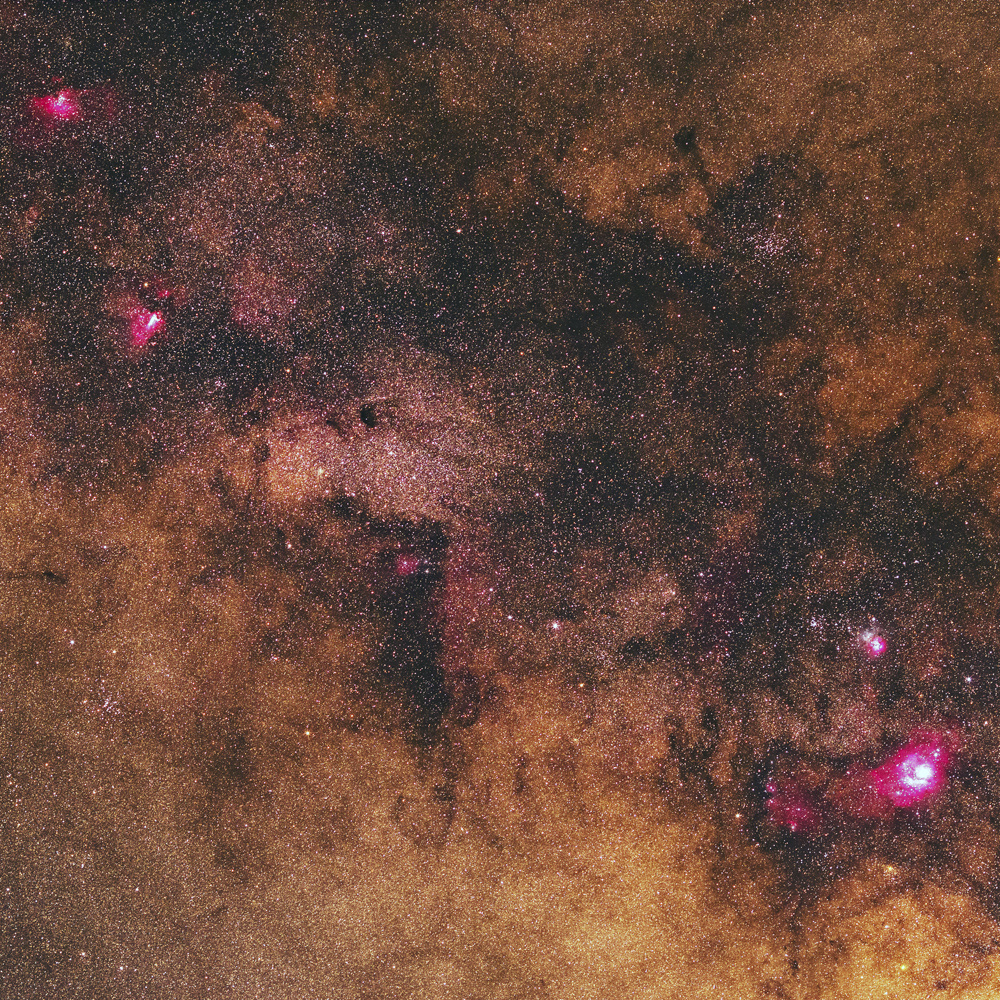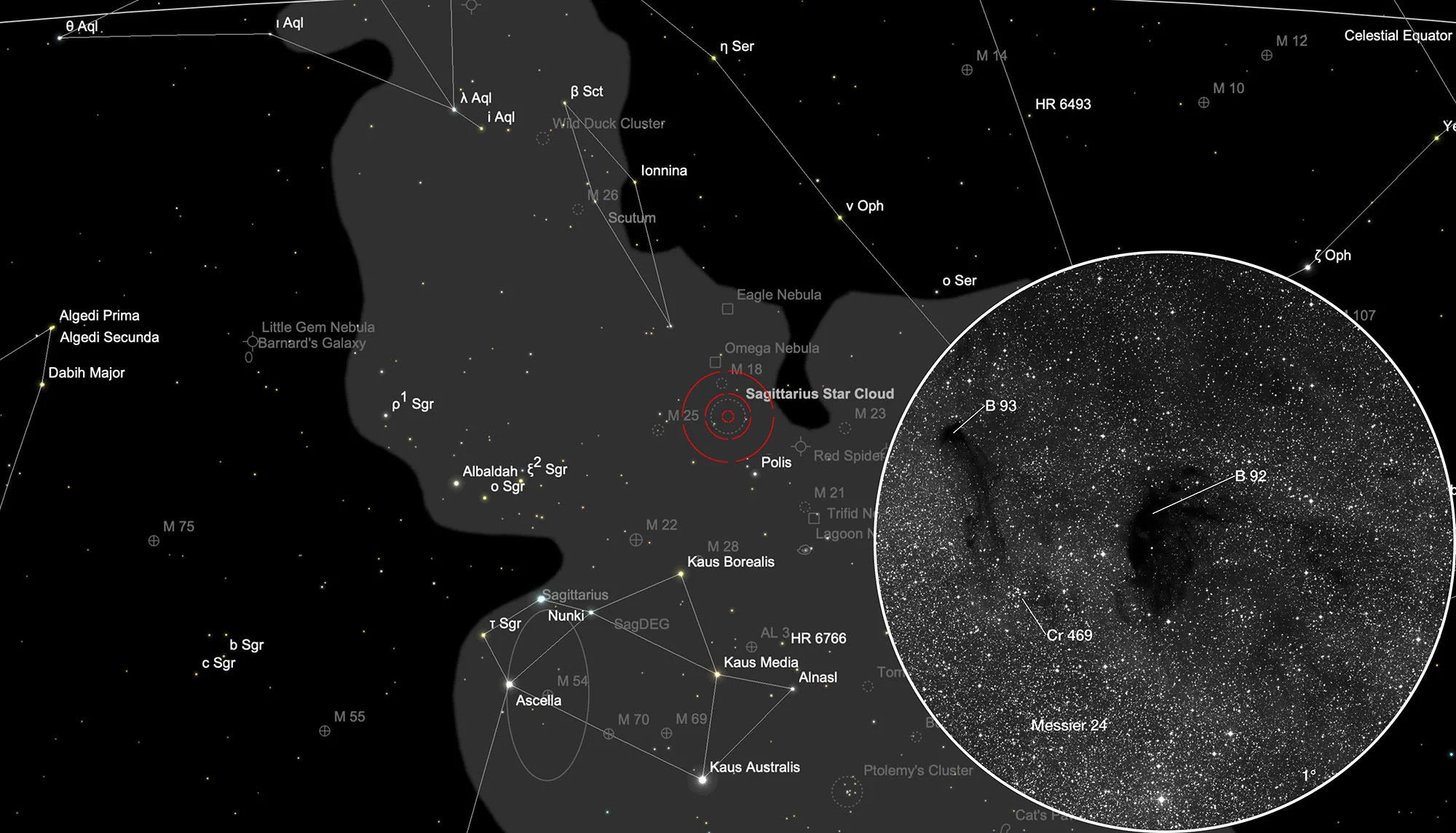Small Sagittarius Star Cloud (Messier 24)

History
On 20 June 1764, Charles Messier recorded this bright spot on the Milky Way as the 24th object in his list. He described the 1.5° large spot as follows: «Cluster on the parallel line of the preceding [M 23] and near the end of the Sagittarius arc in the Milky Way: A large nebula in which there are many stars of different magnitudes: The light that is in this pile spreads is divided into several areas.»
For a long time it was unclear which object Charles Messier meant by M 24. Some identified it with the large star cloud, others with the small star cluster NGC 6603, which is located in the northern part of it. However, it seems certain that the tiny star cluster is too faint to have been discovered with Messier's humble telescope. Also, his description doesn't fit at all. The star cluster NGC 6003 was discovered on 15th July 1830 by John Herschel

Edward Barnard encountered this cloud of stars again in 1905 while searching for dark nebulae, but made a mistake in the position (in epoch 1855: RA 18h 08m statt 18h 18m). Dreyer took over these incorrect coordinates and since he had not originally included Messier's number 24 in his first version of his «New General Catalogue», which appeared in 1888, there was no duplicate entry and so he later added it to the second version of his «Index Catalogue», which was later published added as IC 4715. The description «very large cloud of stars and nebulae» also fits M 24. [4, 196, 217]
Physical Properties
M 24 is neither an open cluster nor a cloud of stars as the name «Small Sagittarius cloud» may suggest. It is a circa 4° wide tunnel in nearby, obscuring interstellar dust clouds that allows a view of the distant stars in the Sagittarius spiral arm of our Milky Way. [645] The «Large Sagittarius Cloud» is about ten degrees further south in the direction of the centre of the Milky Way.
In the northern part of M 24 there are two prominent dark clouds: Barnard 92 and Barnard 93. Barnard 92 is the larger dark cloud with an extension of about 15 'in north / south direction and 10' in east / west direction. A single star with 11 mag (HD 312872) stands lonely and lost in the black void. E. E. Barnard described B 93 in his catalog published in 1919 as "meteoric". Originally it was assumed that these dark spots were empty holes or tunnels in the middle of star masses. The true nature of clouds of non-luminous dust, which blocks the light from stars behind, was not recognized until later. [4, 239] At the southern end of the B 93 is the small, open star cluster Collinder 469.
| Name | RA | Dec | Type | vMag | Dim | MD | Dreyer Description | Identification, Remarks |
|---|---|---|---|---|---|---|---|---|
| NGC 6603 | 18 18 24.0 | -18 24 24 | OCL (I1r) | 11.1 | 4 | 2.880 | !, Cl, vRi, vmC, R, st 15 (M Way) | h 2004; GC 4397; OCL 36; ESO 590-SC17; in M 24 |
| IC 4715 | 18 18 48.0 | -18 33 00 | OCL (*Cloud) | 0.180 | eeL cloud of st and neb | M 24; ESO 591-**1; Sagittarius Star Cloud |
Finder Chart
Messier 24 is located in the constellation Sagittarius. It can best be seen in the months of February to December. Then the constellation is highest above the southern horizon.
Visual Observation
400 mm Aperture: The two dark clouds are a conspicuous feature in the sea of stars of the Small Sagittarius Star Cloud . There is a solitary star in the larger dark cloud Barnard 92. The open star cluster NGC 6603 is a round cluster consisting of many fine stars and stands out clearly from its coarser surroundings. It almost looks like a very loose globular cluster. — 400 mm f/4.5 Taurus Dobsonian, Falera, 6. 9. 2024, Bernd Nies
500 mm Aperture: With the lowest possible magnification (27 mm Tele Vue Panoptic, 87x) the true field of view is 46 arc minutes. Inmidst a vast majority of stars of M 24 the two dark nebulae Barnard 92 and 93 can clearly be recognized and look like diffuse holes. The open star cluster NGC 6603 is very distinctive. — 20" f/4.7 Ursus Dobson, Astrofarm Tivoli, Namibia, 12. 9. 2023, Bernd Nies
